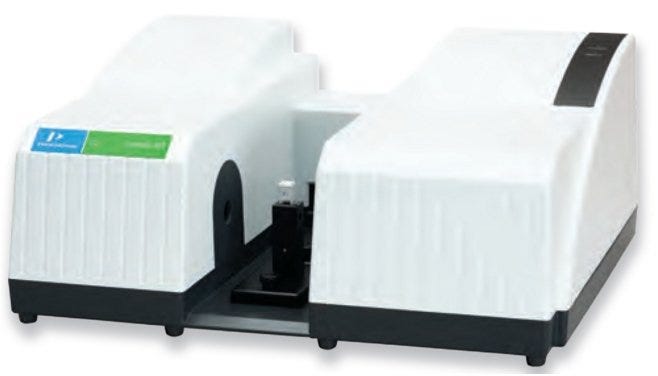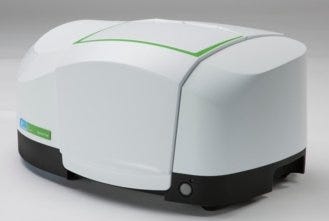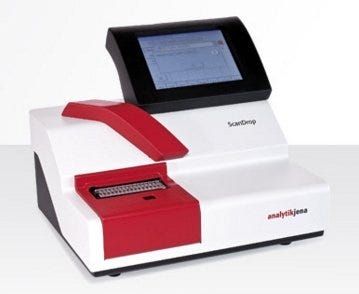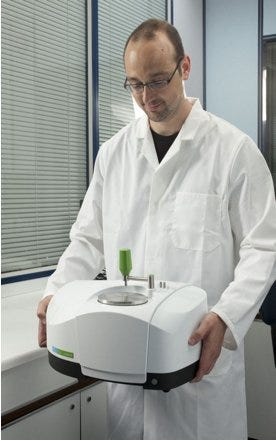Several options exist for determining the composition, concentration, and purity of a laboratory sample. Among the most commonly used techniques are Ultraviolet/Visible (UV/Vis), Infrared (IR), and Atomic Absorption Spectrometry. Each technique is capable of providing some or all of these pieces of information you need. In addition, each of these instruments is capable of interrogated different types of samples, including air, industrial chemicals, biological fluids and foods. Therefore, selection of an appropriate technique for analysis of your sample is essential in obtaining the desired data.
UV/Vis Spectrometers
Several types of UV/Vis spectrophotometers exist, however they all operate on the same basic principle. In short, discrete bandwidths of light are passed through a sample. “Visible” light energy can be seen by humans, while its close neighbor, ultraviolet, cannot. In the entire electromagnetic spectrum ranging from high-frequency, nano-width gamma rays to low-frequency, “long wavelengths” with no definitive size, light (colors) visible to humans makes up a very small percent.

LAMBDA 465 UV/Vis Spectrometer by Perkin Elmer
Pi electrons, depending on their bonding and degree of conjugation, absorb light differentially and at different wavelengths. The initial intensity of the light given off is compared to the intensity of the light that is transmitted through the sample to a detection system. Using Beer’s law, one can easily determine the concentration of the sample. Additionally, because compounds absorb light at unique wavelengths, it is possible to interrogate the composition of the sample.
UV/Vis spectrometers work well for investigating samples that contain transition metals, colored compounds (dyes or pigments), and organic compounds. Biological materials are especially well-suited to analysis by UV/Vis. This type of investigation will reveal wavelengths where the samples absorb light well, thus, if a full spectrum is read, one can determine not only concentration, but also the purity of a given sample. A drawback? UV/Vis does not indicate the exact wavelength being absorbed.
One benefit to this type of analysis is the relatively economical pricing of the instrumentation. The obvious limitation is that the sample must show itself in either the visible or UV bandwidths, which is not the reality for many organic compounds.
Infrared Spectrometers
IR spectroscopy examines samples using the infrared region of the electromagnetic spectrum, the group of frequencies making up visible light’s other close neighbor. In IR spectroscopy, infrared light is transmitted onto a sample. Different elemental bonding will vibrate at differing harmonic frequencies. The absorption of light at these frequencies is then detected and plotted across the IR spectrum. Based on the unique absorbance patterns, researchers are able to identify the particular bonds that occur in a sample. With this information, they can determine the molecules that are present.

Spectrum Two iR Spectrophotometer by Perkin Elmer
IR spectrometry is particularly useful in identifying compounds in organic and inorganic chemistry. The principles of IR spectroscopy have also been applied in manufacturing scientific devices. For example, IR sensors are used for measuring CO2 levels in biological incubators.
IR spectroscopy can investigate samples in nearly any form, which is a noteworthy advantage. Therefore, if one is interested in investigating the composition of an unknown compound, IR spectroscopy can be a very powerful technique. One drawback of this method is that it cannot identify whether the spectrum is a result of single or multiple compounds.
Atomic Absorption Spectrometers
Atomic absorption spectroscopy is capable of determining 70 different elements in a sample. In AAS, the sample is first placed in an atomizer. Atomizers convert the sample into its elemental composition in a gaseous state. A source of radiation is then passed through the sample and measurements are taken. Based on the absorption of this radiation by each component, investigators are able to determine the composition of the sample, as each individual element will have a different (known) absorption rate.

ScanDrop Nano-Volume Spectrometer by Analytik Jena
There are numerous uses for AAS. In clinical laboratories, it detects the presence of metals in biological fluids or tissue samples. In the pharmaceutical industry, AAS may be used to determine if any catalyst remains from synthesis reactions in a manufactured compound. In environmental sciences, it can analyze the metal content in soil or water samples. The obvious benefit of AAS is its ability to determine elemental compositions. Drawbacks of AAS include the cost of the instrumentation and the limited number of compounds identified.
Thus, it is clear that UV/Vis, IR, and AA spectrometers are all powerful instruments that can examine unique properties within organic and inorganic samples. Selecting the appropriate instrument for your laboratory will depend on the characteristics, advantages, and drawbacks listed above. Lastly, one may consider using these techniques in concert for an extremely powerful line of investigation.
See spectrometer instruments offered on Laboratory-Equipment.com.



